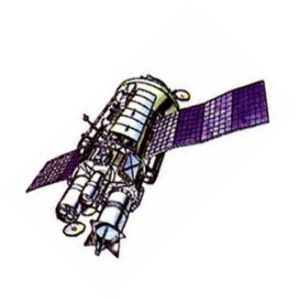
Home - Search - Browse - Alphabetic Index: 0- 1- 2- 3- 4- 5- 6- 7- 8- 9
A- B- C- D- E- F- G- H- I- J- K- L- M- N- O- P- Q- R- S- T- U- V- W- X- Y- Z
Tellura
 Tellura Credit: Khrunichev |
AKA: EKO;Ekologia. Status: Study 1990. Gross mass: 20,000 kg (44,000 lb).
This would be similar to the Priroda module of the Mir space station but designed for an independent free-flying mission.
Tellura would be equipped with spectrometers, radiometers, television cameras, and LIDAR for conducting observations from a 400 to 450 km altitude orbit at 52, 65, or 72 degree inclination. For the higher inclinations an improved Proton-M launch vehicle would be required. The 20 metric ton satellite would have a five year life and was to be launched by 1995. A less sophisticated version of the satellite, dubbed Ekologia, could be launched by 1993. No backers for the concept were forthcoming.
The Salyut Design Bureau of the Khrunichev State Space Scientific Production Centre, with its long history of development of large spacecraft, proposed in 1990 an unmanned, free-flying space station named Tellura-EKO. Based on the TKS-derived augmentation modules for the Mir space station, Tellura-EKO would have a total mass of approximately 20 metric tons, half of which would be available for the remote sensing payload. With a basic maximum diameter of 4.4 m and a length of 12 m, the vehicle would use two large solar arrays to generate up to 5 kW of electrical power.
The Tellura-EKO program would consist of:
- Accommodation of domestic and foreign scientific and special purpose equipment, including:
- unified multi-frequency lidar complex;
- TV-complex;
- radio and spectrometry complexes;
- detachable container with synthetic substances (clouds) sources.
- Recording and transmitting to Earth hydrometeorological, geophysical and ecological information stipulated for by a potential partner, for example:
- size, structure and concentration of atmospheric aerosol stratification layers, velocity and direction of their displacement;
- atmospheric concentration of poisonous sulfurous, ammonia, and nitric gaseous combinations;
- ozone concentration vertical distribution with 1 km altitude resolution in the range of 10 to 80 km;
- wind altitude and spatial parameters measurement with 1 km resolution in the range of altitudes from 3-50 km;
- cloud top altitude measurement with 10 to 100 m accuracy;
- cloud cross-section with 300 to 1200 m and 1000 to 1500 m horizontal spacing;
- atmospheric temperature and density in the altitude range 30 to 100 km with respective accuracy of 2 to 8 degrees K and 2 to 4%;
- slight sodium, potassium, lithium, as well as potassium, magnesium and fermium ion and mixtures at the altitude of 80 to 100 km with 20 to 60% accuracy;
- ionosphere and magnetosphere condition, solar activity, etc.
- Processing the accumulated information and delivering it to the user in a generalized form photographs, photomontage, positives, duplicate negatives, digital information, tape-recorded information through communication links, topical maps and charts, etc.
The 1991 description of Tellura-EKO predicted a first flight as early as 1994 with Western participation. A development investment of 90 million dollars was estimated but operational costs for the period of 1995-1998 were predicted to be only 8 million dollars. The total lifetime of the spacecraft could be up to five years at an altitude of 400-450 km and inclinations of 52-72 degrees. No investor was forthcoming.
Almost simultaneous with the Tellura-EKO Proposal came the Salyut Design Bureau's concept of a slightly less sophisticated spacecraft known as Ekologia. With roughly the same physical characteristics (mass of 21 metric tons, payload of 8-9 metric tons, average power of 3 kW), Ekologia was designed to operate at altitudes of 350-450 km for 3-5 years. Orbital inclinations of 51 degrees, 65 degrees, or 73 degrees were possible. The original Ecologia prospectus indicated that a launch by 1993 was possible. However without foreign investment the program was never started.
Family: Earth, Earth land resource sat. Country: Russia. Engines: KRD-442. Launch Vehicles: Proton, Proton-K. Agency: Chelomei bureau. Bibliography: 119, 453.
Back to top of page
Home - Search - Browse - Alphabetic Index: 0- 1- 2- 3- 4- 5- 6- 7- 8- 9
A- B- C- D- E- F- G- H- I- J- K- L- M- N- O- P- Q- R- S- T- U- V- W- X- Y- Z
© 1997-2019 Mark Wade - Contact
© / Conditions for Use